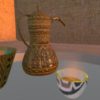There was a maxim inscribed above the entrance to the Temple of Apollo in ancient Greece, which has come to define the search for knowledge of the human race: “Know Thyself.” More than anything else, we seek to understand ourselves and our purpose in the universe. But, as individuals, we too often try to gain that understanding by examining ourselves in isolation, as individual phenomena.
Our thoughts, feelings, and actions — the things that we generally attribute to the essence of ourselves — are almost entirely summative responses to the external stimuli that surround us at every moment. In other words, the things that we think are most representative of ourselves are actually more like reflections of others interpreted, synthesized, and then reenacted by our consciousness.
Think of how your “identity” changes when you are with different people: while with your spouse, you probably use different language and gestures than you do when you are with your friends, your boss, your pastor, or a stranger. Our minds create personas based on the interactions we are having and allow us to take many different “shapes” as we go through life.
What then makes up your real essence, the part of you that is constant, unchanging? Often we call this the soul. If you understand yourself by understanding your interaction with your surroundings, and your interaction with a spiritual presence, then to understand the deepest part of yourself, you have to understand your relationship with that spiritual presence.
Samuel Taylor Coleridge in his poem “Self Knowledge” said, “Ignore thyself, and strive to know thy God!” By seeking an understanding of the divining presence in the universe, and of your relationship with that presence, you will finally begin to understand your spiritual identity.
Jacelyn Thomas
Guest Blogger
Dragon Intuitive
~science,mysticism,spirituality~
This is a guest post from Jacelyn Thomas. Jacelyn writes about identity theft prevention for IdentityTheft.net. She can be reached at: jacelyn.thomas @ gmail.com.



Leave a Reply